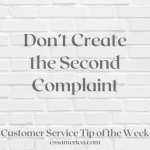We’ve worked with one of our sports clients for over 10 years, and although the main focus of our work is research with their fan base, we also provide informal consulting advice and guidance whenever possible. One approach we’ve talked about on and off for years is the need for them to have a first-time fan or first-time customer strategy for relationship development that is different from their approach with other accounts.
They have an extremely high churn rate with first-time customers, like most businesses do, so there needs to be a clear intent to strategically develop relationships with those customers, learn more about them, and personalize communications and engagement whenever possible.
We had a debrief call recently after one of our major research projects, and one of our client’s staff talked about the fact that they were starting to assign a personal service rep to the new accounts. This is something we have encouraged for years, and we were happy that they’re doing it, but we wondered why this hadn’t been done after our many prior conversations.
The Reason for the Personal Representative
Why do customers – especially first-time customers – often prefer to have a personal representative? It’s about ease and simplicity – having one person you know by name and who knows you by name – one point of contact, one to call, to text, to e-mail to address all their needs. They don’t have to learn your business; they just have to know how to get in touch with Jack, their personal rep. It could be a question about online account access, optional services, policies, fees, program functions/features, etc. Regardless of the topic, all they have to do is call Jack.
This approach provides them a feeling of being taken care of – they know someone they can trust to help them. It’s about their feeling valued – being able to talk to an employee they know, someone who cares about them.
If you want to build true value with your first-time customers, make it easy on them. Build trust with the customer, convey you care about them. Give yourself the ability to be responsive by giving them the ability to get to you easily.
Eliminate barriers to the communications that help you build relationships with new customers.
Signup for FREE Tips! Contact Us More Resources for You Visit Our Home Page
























